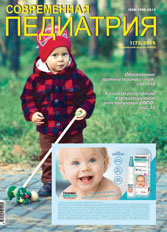Клинико-патогенетическое обоснование и опыт применения интерферона альфа 2b у детей, больных острыми респираторными вирусными иінфекциями
DOI:
https://doi.org/10.15574/SP.2016.73.87Ключевые слова:
острые респираторные вирусные инфекции, дети раннего возраста, лечение, назоферонАннотация
Цель: оценка эффективности и безопасности препаратов интерферона у больных ОРВИ детей в возрасте до трех лет.
Пациенты и методы. Под наблюдением находилось 97 детей с установленным диагнозом ОРВИ, обратившиеся к врачу на 1–2 день от начала заболевания. В основной группе в комплексе лечения дополнительно назначали препарат назального альфа 2b интерферона «Назоферон» в возрастных дозировках. Дети контрольной группы получали только общепринятое лечение.
Результаты. На фоне применения Назоферона наблюдалось уменьшение длительности как основных симптомов заболевания (катаральные явления, температурная реакция), так и явлений интоксикации. На пятые сутки лечения разница между клиническими показателями носила более выраженный характер. Назоферон хорошо переносился, не вызывал дискомфорта со стороны органов дыхания.
Выводы. Хорошая клиническая эффективность и отсутствие нежелательных реакций позволяют рекомендовать Назоферон к использованию в педиатрической практике. Применение Назоферона важно начинать с первых-вторых суток заболевания; возможно применение с профилактической целью.
Ключевые слова: острые респираторные вирусные инфекции, дети раннего возраста, лечение, назоферон.
Библиографические ссылки
Couch RB, Atmar RL, Cate TR et al. 2009. Contrasting Effects of Type I Interferon as a Mucosal Adjuvant for Influenza Vaccine in Mice and Humans. Vaccine. 27(39): 344—348. http://dx.doi.org/10.1016/j.vaccine.2009.06.084; PMid:19607949 PMCid:PMC277820
Brassard DL, Grace MJ, Bordens RW. 2002. Interferon-α as an immunotherapeutic protein. Journal of Leukocyte Biology. 71; 4: 565—581. PMid:11927642
Kugel D, Kochs G, Obojes K et al. 2009. Intranasal administration of alpha interferon reduces seasonal influenza A virus morbidity in ferrets. J Virol. 83(8): 843—851. http://dx.doi.org/10.1128/JVI.02453-08; PMid:19193792 PMCid:PMC2663257
Larussa P. 2011. Pandemic novel 2009 H1N1 influenza: what have we learned? Seminars in Respiratory and Critical Care Medicine. 32; 4: 393—399. http://dx.doi.org/10.1055/s-0031-1283279; PMid:21858744
Steel J, Staeheli P, Mubareka S et al. 2010. Lowen Transmission of Pandemic H1N1 Influenza Virus and Impact of Prior Exposure to Seasonal Strains or Interferon Treatment. J Virol. 84(1): 21—26. http://dx.doi.org/10.1128/JVI.01732-09; PMid:19828604 PMCid:PMC2798408
Mangan NE, Fung KY. 2012. Type I interferons in regulation of mucosal immunity. Immunol cell biol. 90(5). http://dx.doi.org/10.1038/icb.2012.13
Monto AS. 2004. Occurrence of respiratory virus: time, place and person. Pediatric Infectious Disease Journal. 23; Suppl 1: 58—64. http://dx.doi.org/10.1097/01.inf.0000108193.91607.34; PMid:14730271
Pariani E, Martinelli M, Canuti M. Influenza and Other Respiratory Viruses Involved in Severe Acute Respiratory Disease in Northern Italy during the Pandemic and Postpandemic Period (2009—2011). BioMed Research International. 2014(2014), Article ID 241298, 5 pages. http://dx.doi.org/10.1155/2014/241298.
Xi Y, Day SL, Jackson RJ, Ranasinghe C. 2012. Role of novel type I interferon epsilon in viral infection and mucosal immunity. Mucos Immunol. 23. Epub.
Samuel Charles E. 2001. Antiviral Actions of Interferons. Clinical Microbiology Reviews. 14;4: 778—809. http://dx.doi.org/10.1128/CMR.14.4.778-809.2001; PMid:11585785 PMCid:PMC89003
Yohichi Kumaki, Jane Ennis, Ramtin Rahbar et al. 2011. Single-dose intranasal administration with mDEF201 (adenovirus vectored mouse interferon-alpha) confers protection from mortality in a lethal SARS-CoV BALB/c mouse model. Antiviral researches. 89(1): 75—82. http://dx.doi.org/10.1016/j.antiviral.2010.11.007; PMid:21093489 PMCid:PMC3018546
Swerdlow DL, Finelli L, Bridges CB. 2011. 2009. H1N1 influenza pandemic: field and epidemiologic investigations in the united states at the start of the first pandemic of the 21st century. Clinical Infectious Diseases. 52; Suppl 1: 1—3. http://dx.doi.org/10.1093/cid/ciq005; PMid:21342879
Van Hoeven N, Belser JA, Szretter KJ et al. 2009. Tumpey Pathogenesis of 1918 Pandemic and H5N1 Influenza Virus Infections in a Guinea Pig Model: Antiviral Potential of Exogenous Alpha Interferon To Reduce Virus Shedding. J Virol. 83(7): 851—861. http://dx.doi.org/10.1128/JVI.02174-08; PMid:19144714 PMCid:PMC2655560

